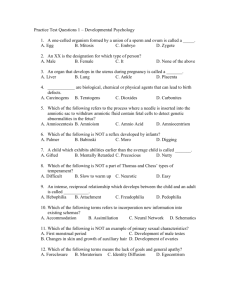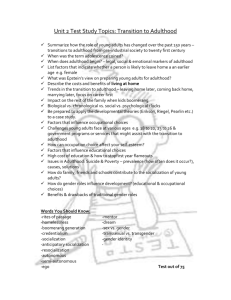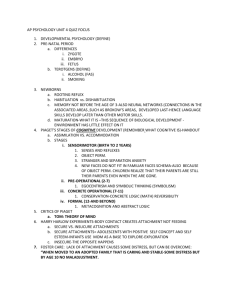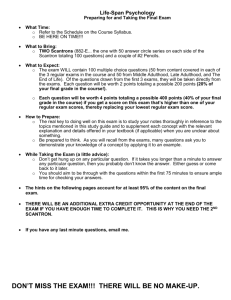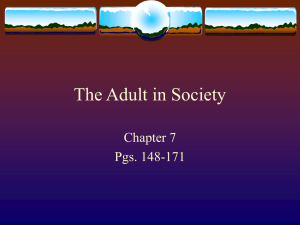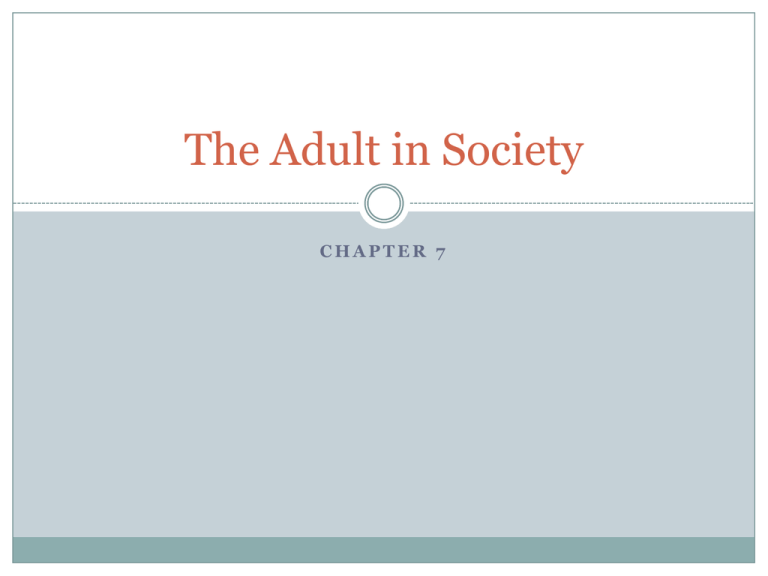
The Adult in Society
CHAPTER 7
Adult Male Development
Daniel Levinson, Yale
Extensive study of adult males through interviews,
determining each man’s life structure: the
combination of statuses, roles, values, goals, beliefs,
and life circumstances that characterize an
individual
Three basic eras of adulthood: early adulthood,
middle, and late adulthood
Each era begins with a transitional period
Early Adulthood
17-22 early adult transition, most important task is
leaving home, physically and psychologically
23-27 entering the adult world, individual is
expected to explore a variety of relationships and
career opportunities, ALSO expected to become a
responsible member of society
Development of an adult dream of accomplishment,
career goals
28-32 Age 30 transition, examine choices made to this
point, crucial to future development because it is often
characterized by shifts in direction
Divorces common
Bad choices can have far reaching consequences
These are called the NOVICE PHASES
33-39 Settling down period, form true commitments,
toward end make conscious effort to establish own
identity separate from mentor (Becoming One’s Own
Man, Levinson).
Middle & Late Adulthood
40-44 Midlife transition, marked by self-
examination, early dreams not fulfilled, reformulate
along more realistic lines, period of moderate to
severe crisis for 80%, become a mentor
45-49 middle adulthood
50-54 Age 50 Transition
55-59 culmination of middle adulthood
60-64 late adult transition
65+ late adulthood
Adult Female Development
Frieze & Sales research, female development is
different
Phase I: Leaving the family: psychological break, less
career, historically marriage
Phase II: Entering the Adult world, multiple roles as
spouse, parent, career put on added strain. Stay out
of workplace while children are young, re-entry
problems
Phase III: Entering the Adult world again
The World of Work
The Labor force- all individuals 16 or older who are
employed in paid positions or are looking for work.
Composition: 1970 38% women, 2000 47% women,
about half of professional jobs (a high status
occupation that requires specialized skills obtained
through formal education)
Rise minority workers as percentage of total labor
force, US largest growing sector is Hispanics
Rise in average education level, 1/3 college degree
Unemployment, full employment is considered 95%
Occupations: types of jobs
Executive, administrative, managerial
Professional specialty
Technical occupations
Sales workers
Administrative support
Service occupations
Precision production, craft, repair workers
Operators, fabricators, laborers
Farming, forestry, fishing
Transportation and material moving
Changing nature of work in America
1900 35% farming
2000 2.6 % farming, fishing and forestry combined
Today, 73% labor force in professional, office, sales
and service jobs
Job Satisfaction
Gold watch vs. job changing
Average American holds 9 jobs between the ages of
18 and 34
Change careers from 5-6 times in a lifetime
The Later Years
Improved health care changes longevity
By 2030, 20% of population will be 65 and older
Gerontology is the study of the processes and
phenomena of aging
Social gerontology is the study of the nonphysical
aspects of the aging process
Young old—65-74
Middle old 75-84
Old-old 85+
Adjustment to retirement, no longer define one self
by occupation
Economic situation key factor in determining
satisfaction
Linked to larger social world, maintaining social
networks contributes to quality of life, volunteering
can replace lost identity
Suicide rate highest for white males as identity is
more tightly tied to work
Questions of engagement v disengagement
Physical and mental functioning
Most slow down as age but most elderly people
retain intellectual abilities throughout life
Alzheimer’s disease, an organic condition that results
in progressive deterioration of brain cells, 8-15% of
population
Dealing with dependency and death
New opportunities
Lobbying groups- Gray Panthers or American
Association of Retired Persons
Part time jobs, volunteering, Service Corps of Retired
Executives (SCORE), Foster grandparent programs



